Detox Me Action Kit by Silent Spring Institute
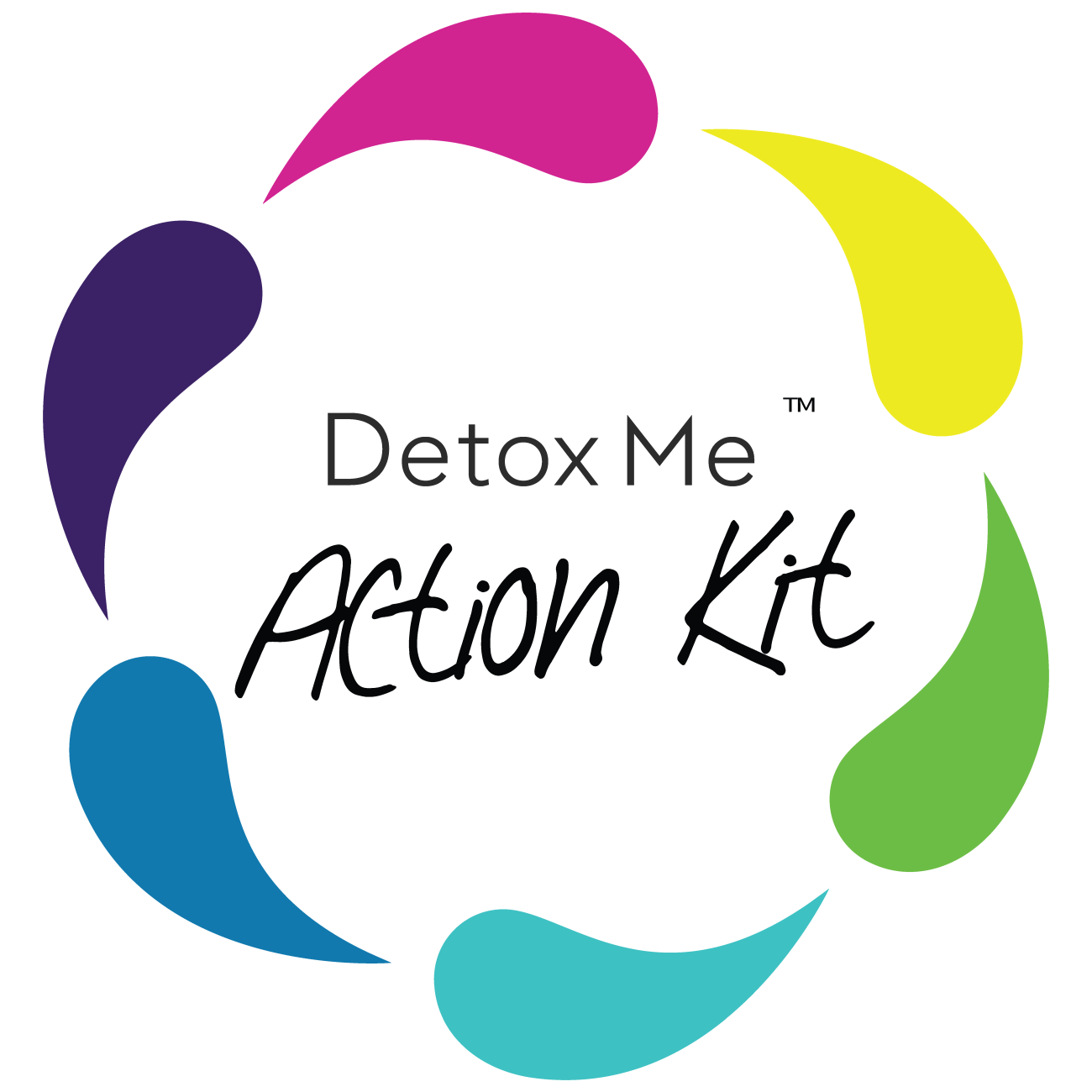 Researchers at Silent Spring Institute want to know more about our exposure to toxic chemicals contained in many household products. We've developed the Detox Me™ Action Kit, a simple urine test that detects the presence of 10 of the most common household chemicals that can accumulate in your body. When you reserve an action kit as part of this campaign, you will submit your own sample and receive a personalized report that compares your results with all other participants in the study.
Researchers at Silent Spring Institute want to know more about our exposure to toxic chemicals contained in many household products. We've developed the Detox Me™ Action Kit, a simple urine test that detects the presence of 10 of the most common household chemicals that can accumulate in your body. When you reserve an action kit as part of this campaign, you will submit your own sample and receive a personalized report that compares your results with all other participants in the study.
Order a Kit: Important Update!
Thank you for visiting our website. We are thrilled to have so many people interested in participating in our biomonitoring study. At this moment, we are busy processing more than 800 kits! As a result, we will not be taking any more orders at this point. We expect to re-open the study again later this year.
If you would like to be notified when we begin enrollment, please send us your email address by filling out this form.
Questions? Contact our research team at detoxmeactionkit@silentspring.org.
What is it?
Every day we are exposed to chemicals in our environment and in the products we use. Many of these chemicals are endocrine disruptors that interfere with the natural hormones in our bodies and can cause health effects.
The Detox Me™ Action Kit is an easy and non-invasive urine test that detects the presence of 10 common household toxics in your body. You'll receive a personalized digital report that compares your results with the aggregate data collected from all Detox Me™ participants and gives you concrete actions you can take to reduce your body's chemical load.
The Detox Me™ Action Kit is part of a scientific study run by Silent Spring Institute, a 501(c)(3) non-profit organization. We're crowdfunding this study to get a better sense of our collective exposure to harmful environmental chemicals. Taking part in the study not only will empower you to live a healthier life, you will also be helping us generate new scientific knowledge about everyday chemical exposures. These data can support stronger policies that protect people from dangerous chemicals in consumer products.
Why should I get tested?
Knowledge is not just power, but a prescription for prevention!
Your personalized report...
- indicates your level of exposure to particular toxics and shows how you compare with others in the study and in the U.S.
- informs you about what is known about the health risks associated with each chemical
- helps identify the likely sources of your exposure
- warns you if your exposure is much higher than others in the study
- shows you how to use our Detox Me™ smartphone app to help you reduce your exposures and see how low you can go
This is good for Silent Spring Institute because...
- it will help us further our mission to empower consumers to take action to lower unnecessary exposures to harmful chemicals called endocrine disruptors that interfere with the body's hormones
- it will allow us to better characterize the public's exposure to toxic chemicals and identify important sources of exposure
- findings from the study could lead to new ways of reducing exposures and better public oversight of the use of chemicals in consumer products
Together, we can create a healthier environment for everyone.
As Seen In...

"What Poisons Are in Your Body?" New York Times, February 23, 2018

"It Tears You Down, and Builds You Up," October 28, 2016 (Season 1, Episode 72)

"The Truth About Toxins," August 12, 2016 (Season 4, Episode 5)
Testimonials / quotes
 "The biomonitoring I did with Silent Spring Institute was revelatory. Not only did it show how easily certain consumer product chemicals cross into our bodies, but I learned how to reduce my levels. It changed the way I think about my household, and the way I think about my body. Regardless of the kinds of actions it inspires—personal, political, artistic—the knowledge is empowering."
"The biomonitoring I did with Silent Spring Institute was revelatory. Not only did it show how easily certain consumer product chemicals cross into our bodies, but I learned how to reduce my levels. It changed the way I think about my household, and the way I think about my body. Regardless of the kinds of actions it inspires—personal, political, artistic—the knowledge is empowering."
 "I sent my urine samples to Silent Spring Institute and was tested for 28 different chemicals all of which were detected in my body burden test, some at alarmingly high levels…You start to realize that you are surrounded by chemicals. Ultimately, the biggest thing you can do is do the best you can and push companies to do better. And in time, maybe we'll all see our collective body burden go down. But it's up to us to make sure things keep moving forward, in the right direction.”
"I sent my urine samples to Silent Spring Institute and was tested for 28 different chemicals all of which were detected in my body burden test, some at alarmingly high levels…You start to realize that you are surrounded by chemicals. Ultimately, the biggest thing you can do is do the best you can and push companies to do better. And in time, maybe we'll all see our collective body burden go down. But it's up to us to make sure things keep moving forward, in the right direction.”
 "We now understand that factors within our control such as diet, exercise, and exposure to environmental chemicals like endocrine disruptors, influence cancer rates—months, years or even decades later. Even exposure of the fetus before birth to certain chemicals can influence cancer risk later in life. Just as the human genome project transformed our fundamental understanding of cancer, biomonitoring and big data have the potential to radically change our understanding of potentially modifiable risk factors for breast cancer and other diseases.”
"We now understand that factors within our control such as diet, exercise, and exposure to environmental chemicals like endocrine disruptors, influence cancer rates—months, years or even decades later. Even exposure of the fetus before birth to certain chemicals can influence cancer risk later in life. Just as the human genome project transformed our fundamental understanding of cancer, biomonitoring and big data have the potential to radically change our understanding of potentially modifiable risk factors for breast cancer and other diseases.”
 "Silent Spring Institute has spent 20 years researching the effects of environmental toxicants on human health. Its researchers have published findings in peer-reviewed scientific journals, and the organization is well-respected in the field of cancer prevention research... Their Detox Me™ mobile app is a clever way to avoid toxic chemicals in everyday products. The app takes people through a crash course on household toxic chemicals and how to avoid them. As you advance through the Detox Me™ curriculum, you receive "badges” to mark your progress. You can also set up reminders for behaviors you'd like to work on.”
"Silent Spring Institute has spent 20 years researching the effects of environmental toxicants on human health. Its researchers have published findings in peer-reviewed scientific journals, and the organization is well-respected in the field of cancer prevention research... Their Detox Me™ mobile app is a clever way to avoid toxic chemicals in everyday products. The app takes people through a crash course on household toxic chemicals and how to avoid them. As you advance through the Detox Me™ curriculum, you receive "badges” to mark your progress. You can also set up reminders for behaviors you'd like to work on.”
The app
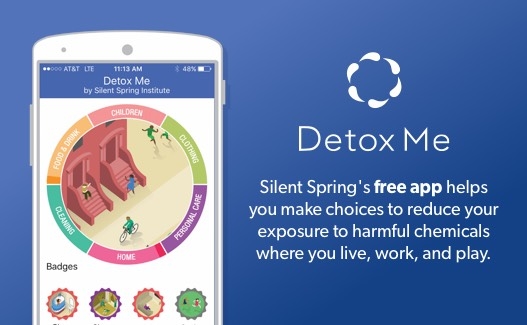 Knowledge is not just power, but a prescription for prevention! Our free Detox Me™ app (available for iPhone and Android) walks you through simple, research-based tips on how to reduce your exposure to potentially harmful chemicals where you live and work--and it keeps track of your progress. Use our app to keep your exposures to these chemicals to a minimum.
Knowledge is not just power, but a prescription for prevention! Our free Detox Me™ app (available for iPhone and Android) walks you through simple, research-based tips on how to reduce your exposure to potentially harmful chemicals where you live and work--and it keeps track of your progress. Use our app to keep your exposures to these chemicals to a minimum.
FAQ
What chemicals does it test for?
Currently, our test screens for 10 of the most common household and environmental chemicals*:
- Bisphenol A (BPA)
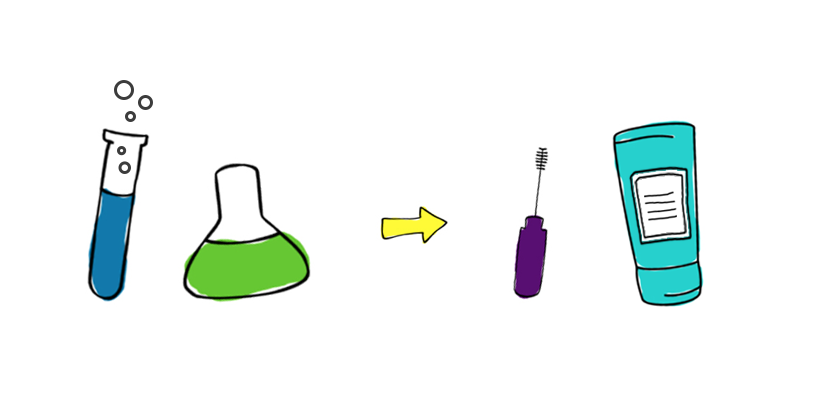
- Bisphenol S (BPS)
- Benzophenone-3 (BP-3)
- Triclosan (TCS)
- Triclocarban (TCC)
- 2,4-dichlorophenol (24-DCP)
- 2,5-dichlorophenol (25-DCP)
- Butyl paraben (B-PB)
- Ethyl paraben (E-PB)
- Methyl paraben (M-PB)
* Additional chemicals may be included in the test depending on the laboratory's capabilities.
Many of these chemicals are endocrine disruptors and all of them can have harmful effects on your body. Some mimic estrogen or block androgen, so they may affect child development, fertility, and increase your risk of some cancers. By understanding the levels of these toxics in your body, you can begin to take action to reduce your exposures.
Through our Action Kit report, and by using our Detox Me™ app, you will learn how to avoid:
- lotions and other personal care products that include parabens and benzophenone
- plastics commonly used in food packaging and processing that include BPA and BPS, a common BPA substitute
- antibacterial products containing triclosan and DCP
Why these 10?
The Detox Me™ Action Kit tests for 10 common endocrine disruptors—chemicals that mimic and interfere with the body's naturally occurring hormones. Hormones regulate many important activities in your body, so endocrine disrupting chemicals raise concerns ranging from effects on fertility to child development to cancer.
These 10 chemicals have been detected at different levels in people throughout the U.S., but detecting these chemicals in your urine doesn't mean you will get sick. It is not known if exposure levels in the general population are above or below levels that cause health effects. Some people are more sensitive to effects than others, and the chemicals can act together, producing effects as a mixture that are not predicted from concentrations of each chemical on its own.
Given these uncertainties, some people may want to reduce their exposures as a precaution while scientists continue to study the effects. (Bergman et. al. 2013) You can learn more about endocrine disruptors and precautionary action in these statements from Project TENDR, the United Nations Environment Programme and World Health Organization, and the Endocrine Society.
- Triclosan and Triclocarban are antibacterial and antifungal agents found in consumer products, including toothpaste, soaps, detergents, toys, and surgical cleaning treatments. Triclosan has been shown to alter thyroid and reproductive hormone levels and reproductive development in animals (Kumar 2009, Stoker 2010, Feng 2016). Studies in breast cancer cells show that both triclosan and triclocarban have the potential to alter the normal activity of estrogen (Gee et. al. 2008 and Ahn et. al 2008). The FDA recently banned the use of triclosan in some personal care products.
- 2,5-DCP is a breakdown product of 1,4-DCB, which is used in mothballs and some toilet deodorizers. 1,4-DCB is classified as a possible human carcinogen (IARC 1999) and has been shown to affect the thyroid gland and thyroid hormone levels in rats (Elcombe et al. 2002). In human adolescents, levels of 2,5-DCP in urine were associated with thyroid hormone levels and hypothyroidism (Wei and Zhu 2016).
- 2,4-DCP is a breakdown product of the widely-used herbicide 2,4-D, and may have other sources. It has been shown to affect the regulation and production of sex hormones and reduce egg hatching success in zebrafish (Ma et al. 2012).
- BPA and BPS are chemicals used in some plastics, food and beverage packaging, and receipt paper. BPA is listed under California Proposition 65 as known to cause reproductive toxicity in women. BPA levels in the general population appear to be below levels where health effects are reported in animal studies, but there isn't clear evidence that current exposures are safe and BPA/BPS can act additively with other chemicals. BPA is estrogenic and alters development of the breast and prostate (Dhimolea et. al. 2014 and Acevedo et. al. 2013). BPS, sometimes used as a substitute to BPA, is estrogenic in rats (Yamasaki et al. 2004) and affects the production and regulation of sex hormones in zebrafish (Ji et al. 2013). BPA and BPS both affect brain development and behavior in zebrafish (Kinch 2015).
- Benzophenone-3 is a chemical found in many sunscreen products. BP-3 has the potential to alter estrogen activity in breast cancer cells (Suzuki et. al. 2005). One study in humans shows changes in hormone concentrations for groups with highest exposure to BP-3 and parabens while another does not (Aker et. al. 2016, Scinicariello et. al. 2016).
- Parabens are the most widely used preservatives in personal care products; they stop fungus, bacteria and other microbes from growing in creams and makeup. Parabens can interact with hormone receptors, similar to natural hormones like estrogen, and have been detected in breast tissue (Okubo et al., 2001 and Barr et al., 2012). For men, parabens may be associated with sperm DNA damage (Meeker et al., 2011).
Who is it for?
Our Detox Me™ Action Kit is for anyone who is curious about the toxic chemicals that might be lurking in their home or residing in their body.
While toxic chemicals in your everyday environment can affect your personal health, they also can affect your children's health. Studies show that exposure to chemicals during critical periods of development—in the womb, during puberty, or during pregnancy—can increase the risk of health problems later in life. These critical periods, commonly referred to as "windows of susceptibility,” represent important stages in life when the body is developing and is most vulnerable to the effects of toxic chemicals.
Exposure to environmental chemicals early in life has been linked with cancer, poor brain development, obesity, diabetes, and other health effects. Because babies and small children spend lots of time on the floor, crawling, playing, and putting their hands in their mouths, they are at higher risk for exposure to pollutants in house dust.
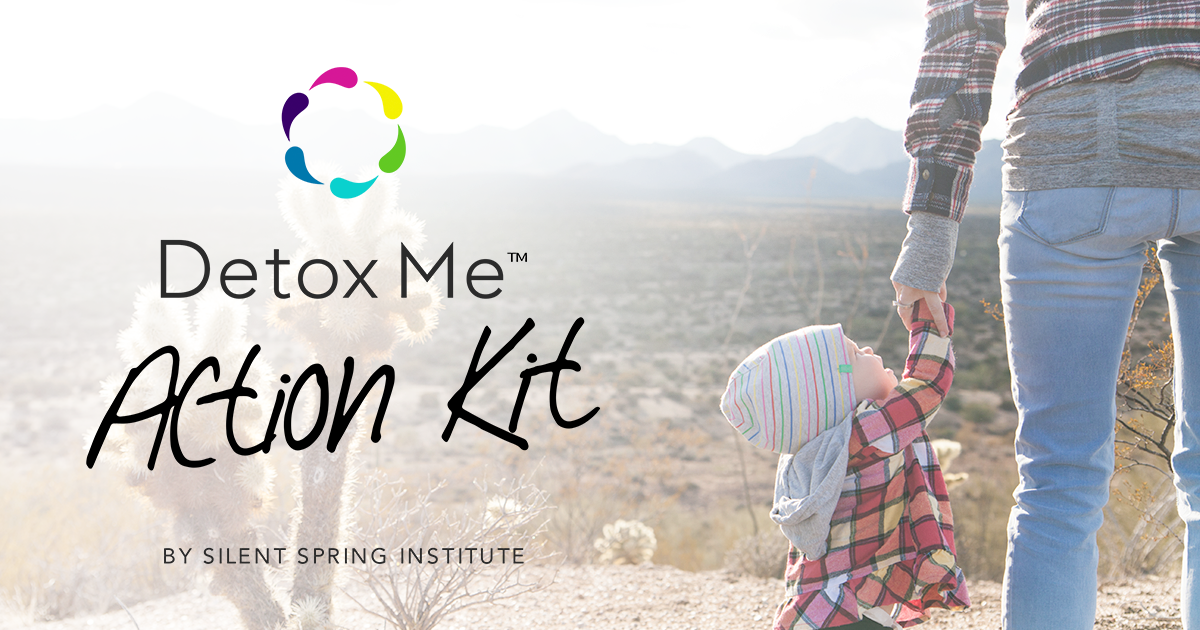 Research by Silent Spring Institute has shown that numerous chemicals in consumer products build up in air and dust indoors, and these chemicals can end up in people's bodies. By understanding what your own chemical levels are, you can take steps to protect your family from potentially harmful exposures, and reduce their risk of developing health problems in the future.
Research by Silent Spring Institute has shown that numerous chemicals in consumer products build up in air and dust indoors, and these chemicals can end up in people's bodies. By understanding what your own chemical levels are, you can take steps to protect your family from potentially harmful exposures, and reduce their risk of developing health problems in the future.
By participating in our study, you will be joining a large community that is working to advance science on chemical exposures and create a healthier environment not only for you and your family, but for everyone and for generations to come.
There are no age restrictions—anyone from birth and up can enroll in our study. However, participants younger than 18 must obtain consent from a parent before joining.
How does it work?
The test
Our test is easy and completely non-invasive. Here's how it works:

The kit contains two glass jars, instructions, a cold pack, a link to our online survey, and a return shipping label.

You'll take our online survey. It takes about 15 to 30 minutes, and you don't have to answer any questions you don't feel comfortable with. Your survey responses, along with your test results will help us personalize the report and recommendations you receive We need this information to learn how specific behaviors affect chemical body burdens.

Then you'll collect two urine samples: one first thing in the morning, one at the end of the day. Place both jars and the cold pack in your freezer for at least 24 hours so they become frozen solid.

Pack the frozen jars and cold pack into the shipping container provided, slap on the pre-paid shipping label, and mail the package back to us.

After our lab analyzes your samples, we'll send you a personalized digital report. That process takes about 8-12 weeks.
Preview the study consent form at https://silentspring.org/detoxme/consentform.pdf
The Report
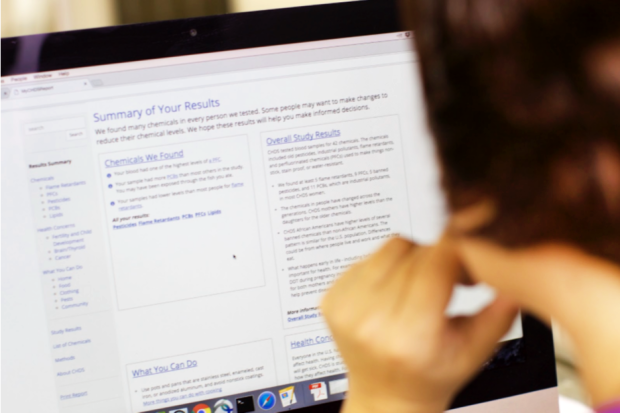
You'll access your report through our secure website. You may review it online, or print your results. We formulate our reports to be easy to understand and to give you actionable goals so you can see your levels of each toxic chemical, understand what we know, and what we don't know, about the associated health risks, and take steps to reduce your exposure.
Preview a sample results report.
What it is... and what it is not
The Detox Me™ Action Kit is...
It's really just an easy urine test that provides amazing, informative, and actionable results for you and important data for our research team to better understand sources of exposure in the general public.
What it is not
The Detox Me™ Action Kit is not a detox formula. There's nothing to drink or eat. It's not scary or invasive. It's not a quick-fix. Instead, it's about making small, simple changes to your daily routine that over time will lower your chemical body burden.
Who's behind this?
The Detox Me™ Action Kit is a project of Silent Spring Institute, a leading scientific research organization dedicated to understanding the link between chemicals in our everyday environment and health, especially breast cancer. Pursuing science for the public interest, Silent Spring's groundbreaking studies produce new knowledge about the health risks associated with toxic chemicals where we live and work—areas of research that have too often been ignored in cancer research.
What are your qualifications?
Founded in 1994, Silent Spring Institute is a recognized leader in the field of exposure science and breast cancer prevention research. Our research was the the first to show that endocrine disrupting chemicals are prevalent in the indoor environment, and that consumer products are the most significant contributor to chemical exposures in the general population. We are also a pioneer in developing innovative tools and ethical methods for sharing chemical exposure and biomonitoring data with participants in large exposure studies.
Silent Spring is staffed by scientists with expertise in epidemiology, toxicology, chemistry, environmental health, and computational science. We collaborate with investigators at Harvard, Northeastern, University of California, Berkeley, U.S. Environmental Protection Agency (EPA), U.S. Centers for Disease Control (CDC), and other top-tier research institutions, as well as with a diverse group of environmental and health advocacy groups.
This project marks the world's first crowdsourced study on exposure to household and environmental toxics.
Update
We recently received approval from our Institutional Review Board to test children, including babies. Now participants, starting from age 0, can enroll in our biomonitoring study. For more information, see the section "Who is it for?” below.”
Why do we need your support?
The more participants that enroll, the more statistical power we will have to draw connections between the products that people use and the level of chemicals in their bodies. As the study grows, we will be able to expand the list of chemicals tested for with the Detox Me™ Action Kit.
Is my contribution tax deductible?
Yes! Because Silent Spring Institute is a registered 501(c)(3) non-profit organization, your contribution is 100 percent tax deductible. Your financial support helps us advance our mission by funding the urine analysis test, purchasing the sampling equipment, and paying for staff time to run the project. Contributions made above the cost of a kit are also 100 percent tax deductible. These additional funds help subsidize kits for people who cannot afford to pay for testing to ensure a broad pool of study participants that reflects the diversity of the U.S. population.
Risks and challenges
- Problems with sample collection. It's important that the samples are kept frozen from the time they are collected to when they are analyzed. If the samples aren't frozen when we get them, we will ask participants to collect another sample and try mailing them again.
- Problems with analysis. There can be failures at the lab that cause the analysis of a sample to not work. In that case, the sample will be re-tested, which will slow down how fast we can give you back your results.